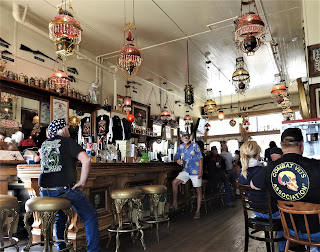If you read the comments at the end of the last blog, you
saw that our friend, Jim, met one of the Idaho Hermits, Buckskin Bill. So of the 3 Hermits, two of them met up with
my friends, what are the odds?
We tasted the cheese we bought in Salmon, “local sheep
cheese.” It is called Aged Carmen
Carrano, “Our signature ‘Mandego-style’ Alpine Artisan Sheep Cheese with a perfectly
balanced and distinctively rich buttery and nutty flavor.” Ingredients:
Raw sheep milk, etc. It was made
at the Mountain Valley Farmstead in Carmen, ID.
The taste was very sharp and it’s kind of crumbly, a bit like extra sharp
cheddar or parmesan. A few slices with a
cocktail are the perfect touch. It's great crumbled on a salad.
 |
| Devil's Orchard |
On 7-14, we stopped at Craters of the Moon National
Monument, just a quick 100 miles down the road.
It is a massive lava field that was created by fissures and rifts in the
earth’s surface that coughed up lava, not like you would imagine flowing down
from the top of a volcano. This stuff
oozed out of cracks, dey ain’t no volcano!
The fields cover thousands of acres and looks like, well, the moon. It all began 15,000 years ago but there has
been activity as recently as 2,000 years ago, Jesus’ birthday. Much of the rock and pulverized rock is iron
pyrite (fool’s gold) and the land sparkles.
We hiked Devil’s Orchard, a field of nasty lava rock and cinders that is slowly beginning to show signs of vegetation.Next, we tackled the Inferno Cone.
It is a steep 300 foot rise to the top from where you can see miles and
miles of lava fields and beyond. We made
it to the top! The whole area is really
pretty weird.
 |
| Oceans of lava rock in Devil's Orchard |
 |
| Rob heading up Inferno Cone |
 |
| We made it to the top! |

This park, Willow Bay Resort, is situated on the edge of
American Falls Reservoir.
The original
dam
was formed by a natural lava flow but in 1923 and again in 1978, humans engineered a dam that created this 56,000 acre reservoir on the Snake River which obliterated the original town of American Falls.
We’re pretty sure we got the best spot in the
park on the end overlooking the water and next to a natural preserve where wildflowers
grow and birds visit. It is shady and
sunny both, depending on the time of day.
In the evening, campfire. In the
morning, sunshine with a cup of coffee and Sudoku. (12 minutes on this one.)
 |
| Hi Roberto! |
Today was kayaking day for Lindy. I paddled out as far as I could, then along
the banks where I heard that there is a moose couple living. I didn’t see the meese (they might have gone
to bed already) but there were big fish jumping (probably rainbow trout since
salmon can’t get here from there), loons, ducks, great northern geese, white
pelicans and cormorants. The water was
as smooth as glass in the small breeze and sunshine. It’s always tranquilizing. Gotta look into a kayak!
 |
| I'm out there... if you look closely! |
 |
Walter DeLaMare's place of business
for 50 years, Union Pacific RR |
Today, in the afternoon, Rob wanted to explore a bit in
Pocatello where his Grampa worked at the Union Pacific RR and where his Mom
grew up. The old offices of the Union
Pacific, which are usually open to tourists, are closed for now, even with a
mask. Rob really wanted to see if he could
find his Grampa’s old office among the artifacts but that was not to be.
The Hotel Yellowstone across the street was
built in 1915.
 |
This was originally the hotel receoption
area, now a bar and lounge |
It was easy to envision
Grampa walking there for lunch or stopping by at the beautiful old bar in the
evening with his buddies.
There is an
old elevator that deserves attention and ultimately, Mike envisions a uniformed
and white-gloved elevator operator who will carry guests up to their
floors.
One small room, constructed of
rich dark wood and the original chandeliers, is furnished with overstuffed
chairs where my imagination says that old rich guys sat and smoked cigars and
discussed the state of world affairs, finance, banks and such while the women
retired to the sitting room nearby to sip tea.
The building is in a transition phase now with struggling new
imaginative owners and a challenging restoration enterprise.
 |
Smoking lounge for old
guys with cigars and a snifter of brandy |
 |
| The elevator: restoration project |
 |
| Hotel Yellowstone in Pocatello, ID (built in 1915) |
A small store called the Butcher Block had one slab of
fresh Alaskan cod left. That poor fellow
is destined for tonight’s grill. Life is
good.




















































